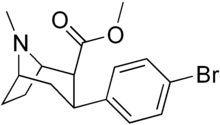 | |
| Identifiers | |
|---|---|
IUPAC name
| |
| CAS Number | |
| PubChem CID | |
| CompTox Dashboard (EPA) | |
| Chemical and physical data | |
| Formula | C16H20BrNO2 |
| Molar mass | 338.245 g·mol |
| 3D model (JSmol) | |
SMILES
| |
InChI
| |
| (what is this?) (verify) | |
(–)-2β-Carbomethoxy-3β-(4-bromophenyl)tropane (RTI-4229-51, bromopane) is a semi-synthetic alkaloid in the phenyltropane group of psychostimulant compounds. First publicized in the 1990s, it has not been used enough to have gained a fully established profile. RTI-51 can be expected to have properties lying somewhere in between RTI-31 and RTI-55. It has a ratio of monoamine reuptake inhibition of dopamine > serotonin > norepinephrine (1.8:10.6:37.4 nM respectively) which is an unusual balance of effects not produced by other commonly used compounds (although RTI-121 is similar, but more DAT selective). It has been used in its Br radiolabelled form to map the distribution of dopamine transporters in the brain.
Modern research seems to confirm the above hypothesis. However, earlier work produced more scattered results. Based upon what is obvious from the table, RTI-31, RTI-51, and RTI-55 are all similarly potent TRIs.
| Compound | CFT | DA | Nisoxetine | NE | Paroxetine | 5-HT |
|---|---|---|---|---|---|---|
| Cocaine | 89.1 | 275 cf. 241 | 3300 (1990) | 119 cf. 161 | 1050 (45) | 177 cf. 112 |
| WIN 35,065-2 | 23 | 49.8 | 920 (550) | 37.2 | 1960 (178) | 173 |
| WIN 35,428 | 13.9 | 23.0 | 835 (503) | 38.6 | 692 (63) | 101 |
| RTI-31 | 1.1 | 3.68 | 37 (22) | 5.86 | 44.5 (4.0) | 5.00 |
| RTI-113 | 1.98 | 5.25 | 2,926 | 242 | 2,340 | 391 |
| RTI-51 | 1.7 | ? | 37.4 (23) | ? | 10.6 (0.96) | ? |
| RTI-55 | 1.3 | 1.96 | 36 (22) | 7.51 | 4.21 (0.38) | 1.74 |
| RTI-32 | 1.7 | 7.02 | 60 (36) | 8.42 | 240 (23) | 19.4 |
Data in above table is from rats brains (1995). More recent work has advocated using cloned human transporters.
See also
References
- Singh S (March 2000). "Chemistry, design, and structure-activity relationship of cocaine antagonists". Chemical Reviews. 100 (3): 925–1024. doi:10.1021/cr9700538. PMID 11749256.
- Loch C, Müller L, Ottaviani M, Halldin C, Farde L, Maziere B. Synthesis of 2β-carbomethoxy-3β-(4-bromophenyl)tropane (β-CBT), a PET tracer for in vivo imaging of the dopamine uptake sites. Journal of labelled compounds & radiopharmaceuticals. 1995; 36(4):385-392.
- Wee S, Carroll FI, Woolverton WL (February 2006). "A reduced rate of in vivo dopamine transporter binding is associated with lower relative reinforcing efficacy of stimulants". Neuropsychopharmacology. 31 (2): 351–62. doi:10.1038/sj.npp.1300795. PMID 15957006. S2CID 7224342.
- Stathis M, Scheffel U, Lever SZ, Boja JW, Carroll FI, Kuhar MJ (June 1995). "Rate of binding of various inhibitors at the dopamine transporter in vivo". Psychopharmacology. 119 (4): 376–84. doi:10.1007/BF02245852. PMID 7480516. S2CID 20022021.
- Kimmel HL, Carroll FI, Kuhar MJ (December 2001). "Locomotor stimulant effects of novel phenyltropanes in the mouse". Drug and Alcohol Dependence. 65 (1): 25–36. doi:10.1016/S0376-8716(01)00144-2. PMID 11714587.
- Kuhar MJ, Carroll FI, Bharat N, Landry DW (August 2001). "Anticocaine catalytic antibodies have no affinity for RTI compounds: implications for treatment". Synapse. 41 (2): 176–8. doi:10.1002/syn.1072. PMID 11400184. S2CID 11862673.
- Carroll FI, Kotian P, Dehghani A, Gray JL, Kuzemko MA, Parham KA, et al. (January 1995). "Cocaine and 3 beta-(4'-substituted phenyl)tropane-2 beta-carboxylic acid ester and amide analogues. New high-affinity and selective compounds for the dopamine transporter". Journal of Medicinal Chemistry. 38 (2): 379–88. doi:10.1021/jm00002a020. PMID 7830281.
- Kozikowski AP, Johnson KM, Deschaux O, Bandyopadhyay BC, Araldi GL, Carmona G, et al. (April 2003). "Mixed cocaine agonist/antagonist properties of (+)-methyl 4beta-(4-chlorophenyl)-1-methylpiperidine-3alpha-carboxylate, a piperidine-based analog of cocaine". The Journal of Pharmacology and Experimental Therapeutics. 305 (1): 143–50. doi:10.1124/jpet.102.046318. PMID 12649362. S2CID 29377097.
- Damaj MI, Slemmer JE, Carroll FI, Martin BR (June 1999). "Pharmacological characterization of nicotine's interaction with cocaine and cocaine analogs". The Journal of Pharmacology and Experimental Therapeutics. 289 (3): 1229–36. PMID 10336510.
| Phenyltropanes (classifications) | |
|---|---|
| 2-Carboxymethyl Esters | |
| (3,4-Disubstituted Phenyl)-tropanes | |
| Arylcarboxy | |
| Carboxyalkyl | |
| Acyl | |
| β,α Stereochemistry | |
| α,β Stereochemistry | |
| Heterocycles: 3-Substituted-isoxazol-5-yl | |
| Heterocycles: 3-Substituted-1,2,4-oxadiazole | |
| N-alkyl | |
| N-replaced (S,O,C) | |
| Irreversible | |
| Nortropanes (N-demethylated) | |